Ohio cleaning up toxic train derailment as pollution 'plume' moves downstream

Cleanup is moving quickly after a train carrying toxic materials derailed in Ohio 11 days ago, Ohio governor Mike DeWine said on Tuesday (Feb 14), while residents and observers questioned the health impacts of pollution that spilled into the Ohio River.
The Norfolk Southern Railroad-operated train derailed on Feb 3, causing a fire that sent a cloud of smoke over the town of East Palestine, Ohio, and forcing thousands of residents to evacuate. After railroad crews drained and burned off a toxic chemical from five tanker cars, DeWine on Feb 8 said that residents could return to their homes.
While DeWine said the pollution did not pose a serious threat to five million people who rely on the river for drinking water, he and several Ohio health and environmental officials cautioned at an afternoon press conference that residents using private wells near the derailment should use bottled water only.
Reporters pressed DeWine and other officials about some residents' complaints of headaches and concern that the government or the railroad were not telling them the entire truth about the pollution and potential harm.

PHOTO: Reuters
One of the chemicals on the train was vinyl chloride, which the US Environmental Protection Agency says is highly flammable and carcinogenic, especially through inhalation. When burned, it decomposes into other toxic compounds including hydrogen chloride.
Dr Bruce Vanderhoff, director of the Ohio Department of Health, said the compounds spilled can cause headaches, eye and nose irritation even at levels considered safe, but that the "measured facts" show air sampling is not reporting any dangers.
The plume of pollution in the Ohio River is moving at 1.61km per hour towards the Mississippi River, nearing Huntington, West Virginia, on Tuesday afternoon, said Tiffany Kavalec, chief of the surface water division of the Ohio Environmental Protection Agency.
Cities in the plume's path can turn off their drinking water intakes as it floats by, Kavalec said. Drinking water tests have not raised concerns and normal water treatment would remove any small amounts of contaminants that may exist, Kavalec said.
Officials said the volume of the river diluted the plume and the plume did not pose a serious threat.
Union warnings
Railroad union officials said they have been warning that such an accident could happen because railroad cost-cutting harmed safety measures.
Asked about the union accusations, a spokesperson for Norfolk Southern Railroad said in an email that "our record (and that of most US Class I railroads) is trending safer".
The train of three locomotives and 150 freight cars was headed from Illinois to Pennsylvania when it derailed. The National Transportation Safety Board (NTSB) said 20 of the cars were carrying hazardous materials, including 10 that derailed.
The NTSB said 38 cars in total left the tracks and that the ensuing fire damaged an additional 12. The NTSB has not commented on the derailment's cause.
Clyde Whitaker, chairman and director of the Ohio State Legislative Board for the International Association of Sheet Metal, Air, Rail and Transportation Workers Transportation Division, said he had notified federal railroad inspectors that crews at one railroad, which he would not name, were disregarding warnings from detectors designed to prevent accidents and was told that their use is voluntary and not subject to regulation.

PHOTO: Reuters
"No one wants to listen until we have a town blown off the face of the earth, then people listen," said Whitaker, whose union is the largest US railroad union representing conductors, engineers and other workers.
DeWine said that he spoke with Norfolk Southern CEO Alan Shaw on Tuesday morning.
"I asked if he would personally guarantee that the railroad would stay there until absolutely everything was clean. He gave me his word and his commitment that the railroad would do that, they would not leave until that was done," the governor said.
The federal Environmental Protection Agency had earlier notified the company it may be liable for cleaning up under the US Superfund law.
Ohio train derailment reveals the dark side
of plastics
ByZahra Hirji
February 16, 2023 —
A Norfolk Southern Railway freight train carrying hazardous materials derailed in fiery fashion in East Palestine, Ohio, on the night of February 3.
The risk of some of those dangerous materials exploding prompted officials to allow the train operator to run what’s called a “controlled explosion” on February 6, releasing known carcinogens and a black smoke into the air. Although residents and businesses were evacuated beforehand and have since been allowed back, many remain hesitant to return home.
Melissa Smith took this photo of the train fire from her farm in East Palestine, Ohio, on Friday, February 3.
Environmental and public health advocates also raised concerns after chemicals contaminated waterways that feed into the Ohio River. A federal investigation into what caused the crash is continuing, as is environmental monitoring inside and outside Ohio.
US Environmental Protection Agency administrator Michael Regan announced on Wednesday (US time) that he would head to East Palestine the next day to visit the disaster scene and meet residents and emergency responders.
The disaster highlights the dangers of the world’s growing reliance on plastics, which are made from two key chemicals of concern, vinyl chloride and butyl acrylate.
“This tragedy reminds us we have to pay attention not to just what happens to plastic when you are done with it, but the whole life cycle of using massive amounts of toxic chemicals that have to be transported all over the world to make plastic products,” said Judith Enck, a former administrator at the EPA during the Obama administration and now an activist against plastic pollution.
The wreckage of the freight train at East Palestine, Ohio, seen in drone footage on Saturday, February 4.
What do we know about the crash?
About 9pm on Friday, February 3, an eastbound Norfolk Southern freight train travelling from Madison, Illinois, and heading to Conway, Pennsylvania, derailed in East Palestine, Ohio.
The train was carrying a mix of items including malt liquor, frozen vegetables and five main hazardous chemicals: ethylene glycol monobutyl ether, ethylhexyl acrylate, isobutylene, butyl acrylate and vinyl chloride.
The National Transportation Safety Board said that of the train’s 150 cars, 38 derailed and an additional 12 were damaged by a fire that lasted for days; 11 of the 20 cars carrying hazardous materials derailed.
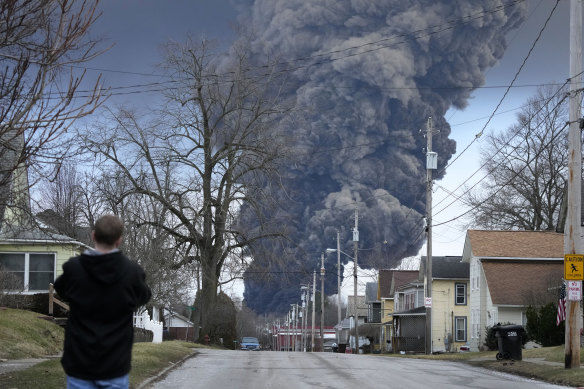
A black plume rises over East Palestine, Ohio, as a result of a controlled detonation of a portion of the derailed Norfolk Southern train on February 6.
There were no fatalities or injuries in the derailment and fire. Investigations into what caused the derailment are ongoing, but surveillance video footage shows the bottom of one rail car overheating beforehand.
“Engineers from the NTSB Materials Laboratory will examine the rail car wheel and axle that potentially experienced a mechanical issue,” NTSB spokesperson Jennifer Gabris wrote in an email to Bloomberg Green.
Why was there a controlled explosion?
In the days following the crash, at least one train car carrying toxic materials started to experience a dramatic rise in pressure. This prompted concerns of a possible “catastrophic explosion” that could send a deadly spray of shrapnel across a wide area.

Ohio National Guard Civil Support Team members prepare to enter an incident area in East Palestine, Ohio, to assess remaining hazards with a lightweight inflatable decontamination system.
To prevent this from happening, Ohio Governor Mike DeWine, Pennsylvania Governor Josh Shapiro, Norfolk Southern and others decided to perform a controlled explosion of five cars carrying chemicals including vinyl chloride, a known carcinogen.
It is unknown how much of the vinyl chloride, which is used to make polyvinyl chloride that’s found in many plastic products and other chemical materials, leaked into the environment ahead of the explosion or during it.
Roughly 4700 people live in East Palestine. Residents and businesses within a few kilometres of East Palestine in both Ohio and Pennsylvania were evacuated ahead of time. Following this explosion on Monday, February 6, residents were allowed to return home starting on Wednesday, February 8.
What about air contamination?
The EPA conducted a range of air monitoring procedures after the crash, including real-time air monitoring using stationary devices set up around the disaster zone and East Palestine community, roving monitoring using hand-held devices and aerial monitors using an ASPECT (Airborne Spectral Photometric Environmental Collection Technology) plane.
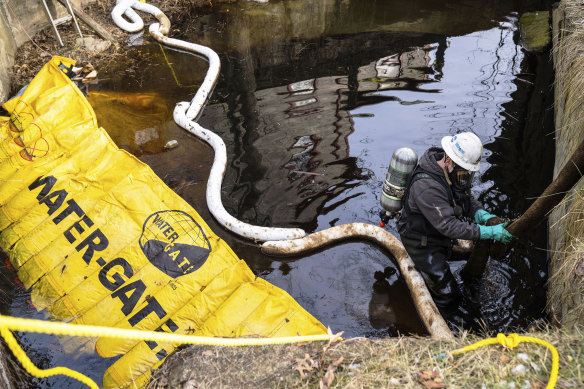
An employee of environmental contractor HEPACO works in a creek along Sumner Street in downtown East Palestine, Ohio on Sunday February 5.
Only particulate matter was detected above the screening levels, and no chemicals or gases were identified at a hazardous level. By the evening of February 13, the EPA had discontinued its community-level air monitoring for phosgene and hydrogen chloride, which can be produced when vinyl chloride combusts. The EPA has been monitoring for chemicals known to be on the train, as well as other materials that those chemicals can break down into or generate upon combustion.
With Norfolk Southern, the EPA also screened the air inside 396 homes and found “no detections” of vinyl chloride or hydrogen chloride; 100 homes still need to be tested.
But this doesn’t mean there weren’t chemicals in the air, possibly at dangerous levels. In one of the EPA’s daily updates, the agency noted that “residents in the area and tens of miles away may smell odours coming from the site”, a result of the byproducts of the controlled burn having a low odour threshold.
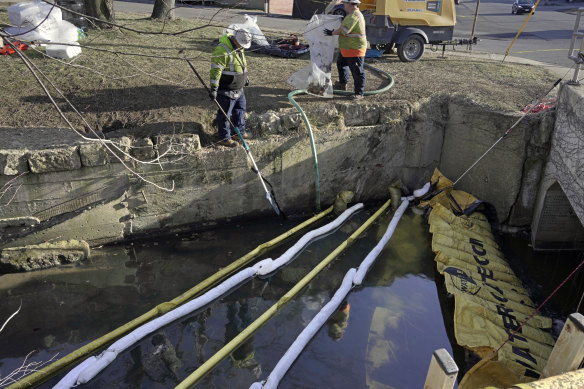
Booms are placed in a stream that flows through the centre of East Palestine, Ohio, as the clean-up continues.
Public health experts also warn that testing indoor air quality isn’t sufficient, especially a week after an event, when chemicals and gases may have dissipated.
“What they have to test is the furniture, the rugs, anything that will absorb contaminants,” says Enck. The EPA did not respond by the time of publication to questions about whether it was testing furniture.
Has there been water contamination?
Soon after the crash, emergency response crews found contaminated run-off at two surface streams — Sulphur Run and Leslie Run — prompting the construction of booms and underflow dams to restrict the flow of contaminated water.
Operations to collect contaminated mud and water have continued, with the Ohio EPA taking the lead on water sampling. At least one of the streams empties into the Ohio River, a drinking source for several states, prompting additional water sampling across state lines.
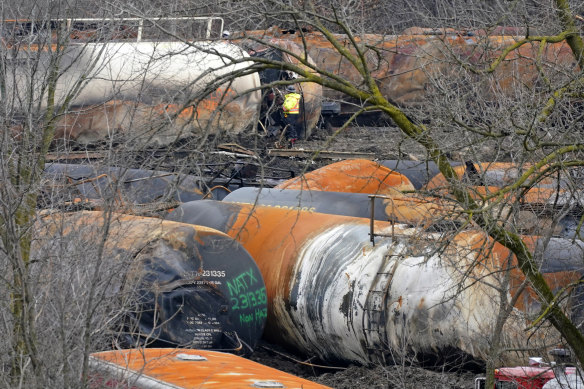
The clean-up of portions of the freight train that derailed in East Palestine, Ohio,.
Although officials have largely declared the drinking water in East Palestine and elsewhere safe, some communities are being advised to drink bottled water.
About 3500 fish have died in the impacted waterways, the Ohio Department of Natural Resources said. The primary toxic chemical identified in the water is butyl acrylate, which is used to make polymers and resins, including those found in plastics and paint.

Authorities in Ohio plan to release toxic chemicals from a derailed train.
Who is responding to the crash?
A complicated web of local, state, and federal officials are responding to the disaster, along with Norfolk Southern and its contractors.
East Palestine’s city officials have contributed to the emergency response, while both the Ohio National Guard and US Department of Defence contributed to modelling done ahead of the controlled explosion.
The NTSB is running the safety investigation into what caused the crash and will ultimately issue safety recommendations after it is done.
RELATED ARTICLE

‘So far, so good’: Controlled release of toxic chemicals keeps Ohio residents evacuated
The EPA took initial water and soil sampling around the crash site, and is the primary source for air monitoring in the community; the EPA is also working with Norfolk Southern to do indoor air screening inside the homes of those who have requested it.
The Ohio EPA is the point agency for water sampling in and around the site, while the Ohio River Valley Water Sanitation Commission and other water utilities along the Ohio River are doing their own water sampling.
Bloomberg

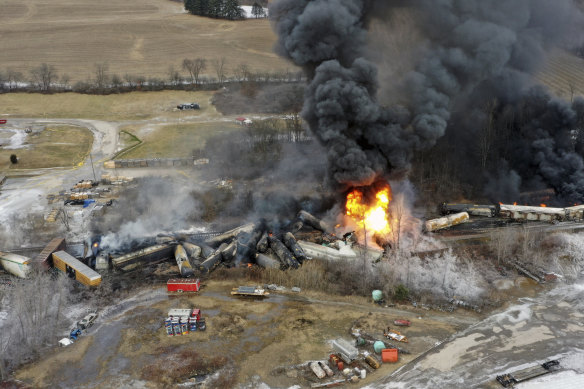
No comments:
Post a Comment